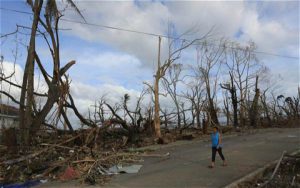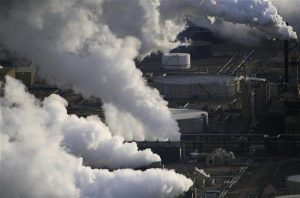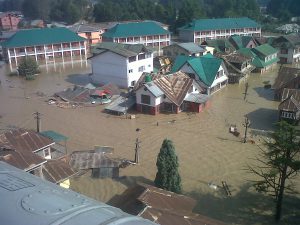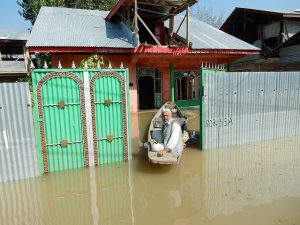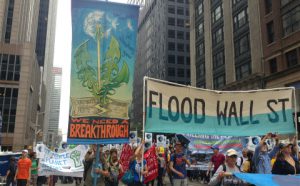Tens of thousands of green activists are heading to New York City to march in solidarity this Sunday, 21 September, in a prelude to a high profile climate change summit called by United Nations Secretary General Ban Ki-Moon. Determined “to galvanise and catalyse climate action” at the New York summit, he challenged heads of state to “deliver concrete action that will close the emissions gap and put us on track for an ambitious legal agreement.”
Five years after COP-15, the climate conference in Copenhagen which saw developing nations and first world polluters blaming one another for a policy stalemate, is the public finally fed up with inaction on global warming from the world’s leaders?
The march’s organisers, who have plastered metro and bus stations with posters and leaflets and unleashed a cyberblitz of publicity on social media, are optimistic. They estimate that as many as 500,000 participants could join a peaceful protest on the streets of Manhattan. With official New York Police parade permits on file, plans are for a non-confrontational and family-friendly weekend with no teargas polluting the air.
After the disappointment of the climate kerfuffle in Copenhagen, where a crowd of nearly 100,000 protestors had rallied until their ranks were thinned halfway through by some 900 arrests, there has been little perceivable progress to curb the world’s reliance on dirty energy. Ultimately no binding commitments were made at Copenhagen.
Consequently, the movement lost some momentum. Raising awareness was not enough. Scientists’ predictions that more droughts, flooding, wildfires and extreme weather would ensue unless carbon emissions were scaled down have come true and the weather havoc makes headlines. (Hurricane Sandy and Typhoon Haiyan were hard to ignore.) Half a decade on, the urgency to stabilise greenhouse-gas concentrations in the atmosphere to 350 parts per million, enough to stave off catastrophic climate change, continues to be a crucial concern.
How will the People’s Climate March in New York City make any difference at all? UN climate change conferences often attract protests, ranging from the marches, pranks and direct actions in Copenhagen, to walkouts by environmental NGOs in Warsaw, and entire alternative summits in Copenhagen and Cochabamba, Bolivia.
One crucial factor in drawing a crowd sizeable enough to convince politicians to act is the high number of decision-makers attending this UN summit. Even though Indian Prime Minister Narendra Modi and Chinese President Xi Jinping will be no-shows, the world press is expected to cover the New York meeting in full force. Further big protest marches will be staged in nine far-flung cities, including London, Delhi, Rio de Janeiro and Melbourne.
The hyperactive environmentalist group which is coordinating the People’s Climate March with a coalition over a thousand grassroots groups and non-government organisations in 150 different countries is named 350.org, referring to the safe level of carbon dioxide in the atmosphere. Jamie Henn, its co-founder and communications director, stresses that Sunday is “a critical moment to build momentum for a new international climate treaty that countries hope to finalise in Paris next year.
“We need very swift action on climate change, not words. Already, climate-change impacts are being felt by frontline communities around the world. These effects are exponentially bad for the most vulnerable and will only get worse if carbon emissions are not cut drastically.”
New recruits
Reaching out beyond the usual base of well-educated liberal supporters is a priority and ideas to engage new recruits to the movement are creative. For example, the Center for Biological Diversity chartered a People’s Climate Train that left from the San Francisco Bay Area on Monday to make whistle stops and collect “concerned citizens” from Sacramento, Reno, Salt Lake City, Denver and Chicago before its arrival in New York City on Thursday in time for the mass march. The aim is to get more supporters on track through teach-ins, mixers and workshops that build on the riders’ enthusiasm and knowledge.
One of the key components of these teach-ins is screening Disruption, a documentary by the prominent filmmakers Kelly Nyks and Jared P. Scott. Released in early September, this film provides dramatic footage and calm scientific assessment of the changing climate and the need for political and technical action. “It’s the movie Al Gore should have made,” observed Claire Greensfelder, a policy and organisational consultant from California who will take part in the People’s Climate March.
She likened the preparations for this weekend to the efforts in organising a gargantuan political rally against nuclear weapons back on June 12, 1982. The result was one million anti-nuclear protestors converging on New York’s Central Park, long before cell phones and the internet could summon a flash mob.
“We keep extending the provisions of Kyoto and coming up against the deadline. This really is a challenge – five years and three conferences, with just two years to get things organised,” Greensfelder pointed out. “Not wanting to cut development is a major obstacle. And the impacts of climate change are not equal.”
Any ragtag gathering of vegetarians, renewable energy geeks and tree-huggers will alienate a certain portion of the American public, many of whom are cynical about the fervency of the green movement and of alternative culture in general. A recent poll showed a majority of Americans still deny or ignore climate change.
“I’m so tired of these extreme environmental wackos costing me more money and trying to force me to change my lifestyle for no reason,” complained Mike Key, a pipefitter, in a recent comment to an online forum for climate sceptics. Interactions with denialists like him during protests against the Keystone Pipeline in 2011 helped regalvanise the green movement. What’s more, indigenous peoples, worried about damage to their sacred sites and health risks from pipeline pollution, began to participate in record numbers.
A panoply of interests
To build momentum for a new international climate treaty that 196 nations hope to finalise in Paris in December 2015, a critical mass of protestors is needed. Reaching out to a youthful American audience, Ban Ki-Moon sat down for an interview with satirist Jon Stewart on a popular US television broadcast, the Daily Show. Ban pressed young people to “raise their voices” on social media. Will they go further and take to the streets of New York?
In addition to the typical crowd of academics and anoraks that attend environmentalist rallies, much more diversity is sought. People of colour will march in New York on Sunday. Scouts, schools, businesses, social justice groups and religious groups will join in too. So will representatives from more than 30 trade unions, including machinists, electrical workers, farm workers, teachers and an assortment of service workers.
For labour to align with the green movement is a giant step towards a renewable economy. But rather than recycling old means of protest, some seasoned green campaigners like Kevin Zeese demand direct action and obstruction to get the climate message across. Using the tactics popularised by the Occupy Movement risks alienating potential supporters and lawmakers, say others. By inviting in a panoply of regional interests, the global climate movement is taking a new tack. It’s spelled out on the invitation to the People’s Climate March: “To change everything, we need everyone on board.”

